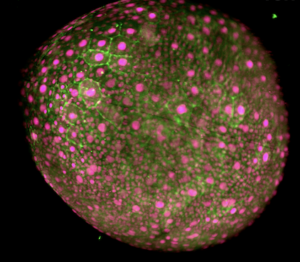What is “Bioelectrics” and why should an embryo care?
Every cell, even non-neuronal cells, have an electrical charge across its cell membrane. These membrane charges (or “potentials,” aka Vmem) are caused by differing ion concentrations inside and outside the cell. Interestingly, multicellular organisms can display patterns of differential “bioelectrics” across the body plan with different cells exhibiting different states of membrane potentials.
 What could these bioelectric states be doing? It was demonstrated that altering bioelectric states in amputated flatworms can alter the type of tissues they form during regeneration (See Mike Levin’s Lab). Surprisingly, less is known about how bioelectric signaling may pattern the developing embryo.
What could these bioelectric states be doing? It was demonstrated that altering bioelectric states in amputated flatworms can alter the type of tissues they form during regeneration (See Mike Levin’s Lab). Surprisingly, less is known about how bioelectric signaling may pattern the developing embryo.
We hypothesize that bioelectric signaling provides a robust mechanism that influences the more well-known growth factor systems in place to control embryonic development. We are establishing new transgenic reporter systems to visualize bioelectric patterns in the early zebrafish embryo. We are also employing a variety of approaches to systematically test the requirements of bioelectric signaling during all stages of embryonic development.
This work is funded by the National Institutes of Health.